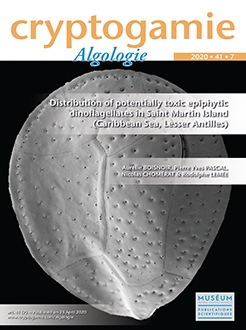Aurélie Boisnoir, Pierre Yves Pascal, Nicolas Chomérat, Rodolphe Lemée
Cryptogamie, Algologie 41 (7), 47-54, (23 April 2020) https://doi.org/10.5252/cryptogamie-algologie2020v41a7
KEYWORDS: dinoflagellates, Caribbean Sea, Ostreopsis, Gambierdiscus, Prorocentrum, ciguatera fish poisoning(CFP)
For the first time, distribution of epiphytic dinoflagellates was studied in Saint Martin Island (Lesser Antilles) during the cyclonic season (between September 1st and 3rd, 2015). The present study provides a semi-quantitative analysis because the fresh weight of each macrophyte was estimated around 10 g. The identified genera were: Ostreopsis J.Schmidt, Prorocentrum Ehrenberg, Coolia Meunier, Amphidinium Claperède & Lachmann, and Gambierdiscus Adachi & Fukuyo in order of decreasing abundance. Highest average abundance values of the genera Ostreopsis and Amphidinium were hosted by macrophytes of the Phaeophyceae class with c. 15 000 and 60 cells g–1 respectively. Epiphytic Coolia cells were mainly observed on seagrasses with the highest average abundance value of c. 1000 cells g–1 whereas the genera Gambierdiscus and Prorocentrum were most often associated with Florideophyceae with the highest average abundances of c. 70 and 1500 cells g–1 respectively. This preliminary study indicates the most relevant locations to survey the biodiversity of potentially toxic epiphytic dinoflagellates in Saint Martin Island.

